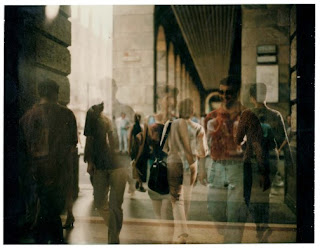Philip-Lorca diCorcia
Thousand
Gianni
Hustler Series
I chose to contemplate these 3 images by DiCorcia as they represented different styles within the Tableau genre. One of DiCorsia's methods is his shift from simple Tableau into the real world. A blending of the cinematic and the realistic, again highlighting how fluid this genre can be. This is very evident in the first of his images above (thousand), but to me this image fails the genre and doesnt captivate or draw me in to any narrative interpretation nor wonder, and thus I think in this instance he has crossed the indefinable line between Tableau and stylised general art photography.
The second of the two images to my way of thinking is pure Tableau-vivant. Its Kitsch, ambiguous and almost bizarre scene, leaves you wondering both what's gone on, what's happening and what's going to unfold. Its dark camp humour, has a relaxed intensity. It is 100% constructed and contrived.
The last of the 3 shots above is from his street hustler series, and makes a powerful comment about survival on the streets. The somewhat juxtaposed model is positioned/staged in amongst the visual clues of suburbia, and "normal" everyday folk habitat. Placed in the shadows, the protagonist only daring to emerge at dusk into the urban jungle. This image is a blending of the former 2 techniques in as much as it is partially staged/lit and partially vernacular.
Izima Kaoru
From my initial research it appears a though Izima Kaoru has a pre-occupation with death, specifically younger females. This is evident in many of his series. With these series some are landscape directed, and some are retail, and some series are street for instance. Since this seems to be his primary albeit macabre specialty, I chose 2 of these such images that held my attention longer than the others
Corpse Death
The first one I chose because it has a dark comedic quality, which as much as some other examples of tableau have humour, they are none the less NOT comedic. So this image is quite a rarity in the genre. Also unlike others in the genre the "what happened here" narrative could be very obvious. But the models undignified death was perhaps only eclipsed by her undignified life. Hence the title Corse death, adding weight to her having existed a living death. Visually tied to the empty booths of diners who have sated themselves, and then left, its a sad indictment of the human condition. This human element/struggle is a common identifier with tableau, and forces us to reflect on our own behaviours.
The second and third images I chose because it emphasises Kaoru's use of vibrant colours, strong compositions and lighting in so far as if it wasnt for the dead female in the images they could possibly pass as everyday images. In this series he took both an image from close up and one from a considerable distance, again both with the absence of other humans. The allegory is one of isolation, loneliness and futility.
Again to me this technique doesn't quite resonate as strongly as other Tableau styles but never the less has its place.






great examples - I love the tension between the graphic and the photographic in the last set. You are right, there is a slider between complete construction and complete realism and the best know how to manage this balance. Nice articulate analysis.
ReplyDelete